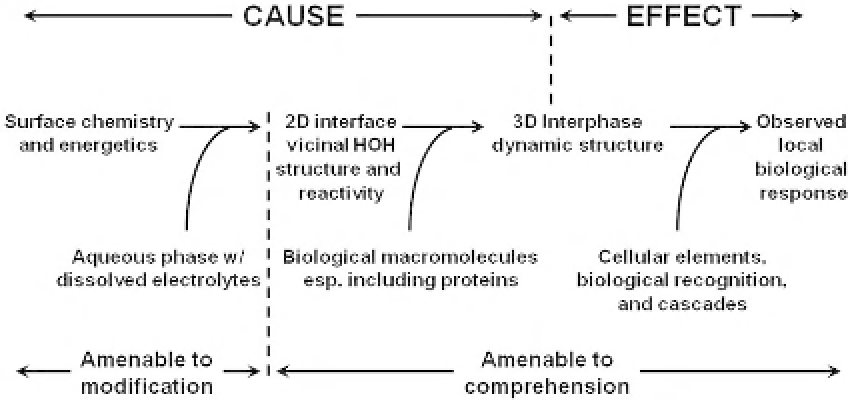Biomedical Engineering Reference
In-Depth Information
of nanometers associated with water molecules
(molecular contact) to the scale of the biomedi-
cal device or patient into whom an implant
might be placed (organism scale). An example
is thrombophlebitis, mentioned in Section
8.2.4
.
The initial molecular interactions occurring at
the catheter surface lead to embolus formation
that dislodges from the catheter surface, travel-
ing to a distal site. Clearly, then, the biological
response to materials spans a diversity of time
and length scales and, as such, is a very complex
biophysical phenomenon.
Sometimes the overall biological response can
be favorable, or at least not entirely unfavorable.
But in most situations the linked cause-and-
effect reactions of
Figure 8.3
lead to poor bio-
compatibility. Generally speaking, the higher in
the healthcare pyramid of
Figure 8.1
the bioma-
terial application falls, the more difficult it is to
achieve biocompatibility. As examples, sterile-
disposable cell-culture containers are widely
and successfully used in biotechnology and
would thus be considered biocompatible. But
there are no materials that do not induce blood
coagulation to some degree when used in a total-
replacement artificial heart, and this is a major
impediment to developing such advanced car-
diovascular medical devices. Most materials
eventually become encapsulated in fibrous scar
tissue when implanted into soft tissues, greatly
complicating functionality of implanted elec-
tronic sensors, such as a glucose sensor to be
used in treatment of diabetes. Williams' Four
Components of Biocompatibility make it very
clear that biocompatibility must be engineered
at the first step of
Figure 8.3
. Otherwise, the
cause-and-effect cascade leading to the systemic
biological response will lead to poor biocompat-
ibility. The following section examines this criti-
cal first surface interaction step in somewhat
more detail.
8.2.4.2 Target of Surface Modification
Figure 8.4
is a kind of descriptive chemical reac-
tion that provides more detail to the surface
interaction step of
Figure 8.3
. According to the
preceding discussion, the cause of the biological
response to materials is the formation of a
dynamic interphase. Whereas all of the various
steps leading to this interphase might be ame-
nable to comprehension in detail someday, none
is subject to any proactive manipulation to
FIGURE 8.4
Descriptive chemical reaction expanding the surface interaction step of Williams' Four Components of
Biocompatibility (
Figure 8.3
), identifying formation of a dynamic interphase region as the primary cause of the local biologi-
cal response. Whereas the steps leading to the local biological response to a biomaterial may someday be amenable to full
comprehension, only the surface chemistry that interacts with the aqueous phase in establishing vicinal-water structure and
reactivity can be modified to control biocompatibility.


